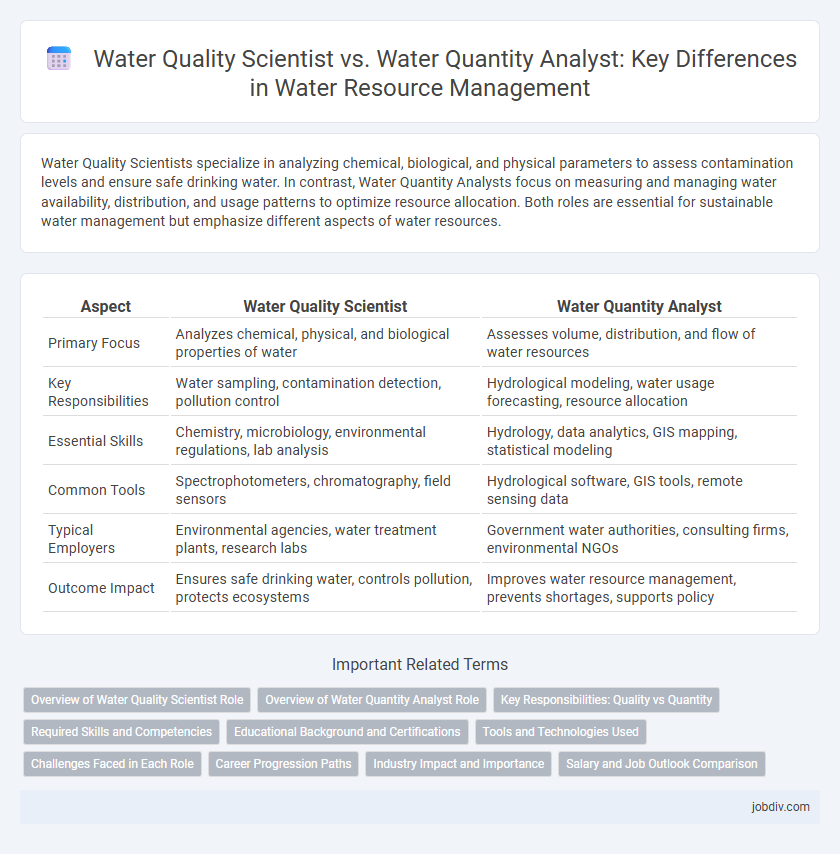Water Quality Scientists specialize in analyzing chemical, biological, and physical parameters to assess contamination levels and ensure safe drinking water. In contrast, Water Quantity Analysts focus on measuring and managing water availability, distribution, and usage patterns to optimize resource allocation. Both roles are essential for sustainable water management but emphasize different aspects of water resources.
Table of Comparison
| Aspect | Water Quality Scientist | Water Quantity Analyst |
|---|---|---|
| Primary Focus | Analyzes chemical, physical, and biological properties of water | Assesses volume, distribution, and flow of water resources |
| Key Responsibilities | Water sampling, contamination detection, pollution control | Hydrological modeling, water usage forecasting, resource allocation |
| Essential Skills | Chemistry, microbiology, environmental regulations, lab analysis | Hydrology, data analytics, GIS mapping, statistical modeling |
| Common Tools | Spectrophotometers, chromatography, field sensors | Hydrological software, GIS tools, remote sensing data |
| Typical Employers | Environmental agencies, water treatment plants, research labs | Government water authorities, consulting firms, environmental NGOs |
| Outcome Impact | Ensures safe drinking water, controls pollution, protects ecosystems | Improves water resource management, prevents shortages, supports policy |
Overview of Water Quality Scientist Role
Water Quality Scientists analyze physical, chemical, and biological parameters in water to assess contamination levels and ensure safety for ecosystems and human use. Their work involves collecting samples, conducting laboratory tests, and interpreting data to monitor pollution, compliance with regulatory standards, and public health risks. Expertise in hydrology, environmental science, and chemistry is essential for accurate evaluation and water resource management.
Overview of Water Quantity Analyst Role
Water Quantity Analysts specialize in assessing and managing the availability, distribution, and flow of water resources to ensure sustainable usage and allocation. They utilize hydrological data, statistical models, and geographic information systems (GIS) to monitor water supply trends and forecast potential shortages or surpluses. This role is critical in supporting water resource planning, infrastructure development, and policy-making to address challenges related to water demand and climate variability.
Key Responsibilities: Quality vs Quantity
Water Quality Scientists focus on monitoring chemical, physical, and biological parameters to ensure water safety and compliance with environmental regulations. Water Quantity Analysts specialize in measuring and predicting water availability, managing water resources, and assessing hydrological data for sustainable distribution. Both roles require expertise in data analysis, but emphasize distinct aspects of water management--quality versus volume.
Required Skills and Competencies
Water Quality Scientists must possess expertise in chemical analysis, microbiology, and environmental regulations to assess and ensure the safety of water resources. Water Quantity Analysts require strong skills in hydrology, data modeling, and statistical analysis to evaluate water availability and distribution. Both roles demand proficiency in Geographic Information Systems (GIS) and critical problem-solving abilities for effective water management.
Educational Background and Certifications
Water Quality Scientists typically hold degrees in environmental science, chemistry, or biology, with certifications such as Certified Water Quality Professional (CWQP) enhancing their credentials. Water Quantity Analysts often have educational backgrounds in hydrology, civil engineering, or geography, complemented by certifications like the Certified Hydrologic Technician (CHT) or Professional Engineer (PE) license. Both roles require a strong foundation in water resource management, but their specialized training reflects distinct focuses on water quality testing versus water supply analysis.
Tools and Technologies Used
Water Quality Scientists utilize advanced laboratory instruments such as spectrophotometers, chromatography systems, and molecular analysis tools to assess contaminants and ensure safe water standards. Water Quantity Analysts rely on hydrological modeling software, remote sensing technologies, and GIS platforms to monitor and predict water availability and distribution. Both roles integrate sensor networks and data analytics but differ significantly in the emphasis on chemical analysis versus resource measurement technologies.
Challenges Faced in Each Role
Water Quality Scientists face challenges such as detecting and analyzing contaminants in complex water samples, ensuring compliance with environmental regulations, and addressing the impacts of pollution on ecosystems and public health. Water Quantity Analysts encounter difficulties in managing water resources amid fluctuating supply and demand, modeling hydrological processes accurately, and mitigating risks related to droughts, floods, and climate change. Both roles require advanced technical skills but differ in focus, with quality experts prioritizing chemical and biological factors and quantity analysts emphasizing hydrological data and resource allocation.
Career Progression Paths
Water Quality Scientists typically advance by specializing in environmental toxicology, regulatory compliance, or water treatment technologies, often moving into senior research roles or environmental consultancy. Water Quantity Analysts progress through roles involving hydrological modeling, water resource management, and policy development, with career paths leading to water supply planning or infrastructure project management. Both careers offer opportunities in government agencies, private sector firms, and non-profit organizations focused on sustainable water resource management.
Industry Impact and Importance
Water Quality Scientists play a crucial role in monitoring and improving the chemical, physical, and biological characteristics of water to ensure safety and compliance with environmental regulations, directly impacting public health and ecosystem sustainability. Water Quantity Analysts focus on assessing water availability, usage patterns, and resource management to address supply challenges and support sustainable water distribution in industries such as agriculture, manufacturing, and urban planning. Both roles are essential in maintaining balanced water resource management, with Water Quality Scientists safeguarding water safety and Water Quantity Analysts optimizing water supply for economic and environmental stability.
Salary and Job Outlook Comparison
Water Quality Scientists typically earn a median annual salary of around $70,000, reflecting their expertise in testing and analyzing water samples for pollutants and compliance with environmental regulations. In contrast, Water Quantity Analysts often have a slightly higher median salary near $75,000, emphasizing their skills in managing water resource distribution and supply forecasting. Job outlook for Water Quality Scientists is projected to grow by 9% due to increasing environmental concerns, whereas Water Quantity Analysts may see a growth rate of about 8%, driven by the need for sustainable water management amid climate change.
Water Quality Scientist vs Water Quantity Analyst Infographic

 jobdiv.com
jobdiv.com